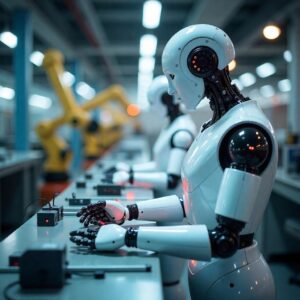Introduction
Table of Contents
ToggleIn recent years, deep learning AI has emerged as one of the most transformative technologies across various sectors, reshaping industries and redefining the ways we approach complex problems. From healthcare to finance, transportation to entertainment, deep learning is at the forefront of innovation, driving advancements that were once thought to be the realm of science fiction. This comprehensive blog post will delve into the intricacies of deep learning AI, exploring its foundational concepts, applications, advantages, challenges, and future prospects. By the end, readers will have a holistic understanding of deep learning AI and its potential to revolutionize our world.

What is Deep Learning AI?
Definition
Deep learning is a subset of machine learning, which itself is a branch of artificial intelligence (AI). It involves the use of artificial neural networks to simulate human-like learning. Unlike traditional machine learning algorithms that rely on manual feature extraction, deep learning models automatically learn to represent data through multiple layers of abstraction.
How It Works
Deep learning models consist of layers of interconnected nodes, known as neurons, which process data. Each neuron receives input, applies a mathematical transformation through an activation function, and passes the output to the next layer. The architecture of a deep learning model can be broadly categorized into three types of layers:
- Input Layer: The first layer that receives the raw data.
- Hidden Layers: Intermediate layers that perform computations and learn complex patterns.
- Output Layer: The final layer that produces the model’s predictions.
The learning process involves adjusting the weights of the connections between neurons based on the input data and the desired output. This is achieved using a method called backpropagation, where the model’s error is calculated and propagated back through the network to update the weights.
Key Components
- Neurons: Basic units of a neural network that process information.
- Activation Functions: Functions that determine the output of a neuron based on its input. Common activation functions include ReLU (Rectified Linear Unit), sigmoid, and softmax.
- Loss Functions: Metrics used to evaluate the performance of the model during training. Examples include mean squared error for regression tasks and cross-entropy loss for classification tasks.
The Evolution of Deep Learning AI
Historical Context
The journey of deep learning AI can be traced back to the early days of artificial intelligence in the 1950s. Researchers began exploring neural networks as a means to mimic human cognitive functions. However, early attempts faced significant challenges, including limited computational power and inadequate data.
The revival of interest in deep learning occurred in the 2000s, driven by advancements in computing power, particularly with the use of Graphics Processing Units (GPUs). This allowed researchers to train larger and more complex neural networks. The breakthrough moment came in 2012 when a deep learning model, AlexNet, won the ImageNet competition, significantly outperforming traditional computer vision methods.

Pioneering Research
Several key figures have played a pivotal role in the development of deep learning:
- Geoffrey Hinton: Often referred to as the “Godfather of Deep Learning,” Hinton’s research on backpropagation and neural networks laid the foundation for modern deep learning techniques.
- Yann LeCun: Known for his work on convolutional neural networks (CNNs), LeCun’s contributions have significantly advanced the field of image recognition.
- Yoshua Bengio: A leading figure in deep learning research, Bengio has explored various aspects of neural networks and their applications.
Technological Advancements
The growth of deep learning has been fueled by several technological advancements:
- Big Data: The availability of large datasets has enabled deep learning models to learn from diverse and rich information sources.
- Cloud Computing: Cloud platforms provide scalable resources for training deep learning models, making it accessible to a broader audience.
- Open Source Frameworks: Libraries such as TensorFlow, PyTorch, and Keras have democratized deep learning, allowing developers to build and experiment with models easily.
Applications of Deep Learning AI
Deep learning AI has found applications across various industries, driving innovation and efficiency. Below are some of the most impactful applications:
Healthcare
- Medical Imaging: Deep learning algorithms are used for analyzing medical images, such as X-rays, MRIs, and CT scans. These models can detect anomalies, assist in diagnosis, and improve patient outcomes. For example, convolutional neural networks (CNNs) have shown remarkable accuracy in identifying tumors and other conditions in radiology.
- Drug Discovery: Deep learning accelerates the drug discovery process by analyzing chemical compounds and predicting their potential efficacy. By leveraging historical data, researchers can identify promising drug candidates more efficiently.
- Predictive Analytics: Deep learning models can analyze patient data to predict disease progression, readmission rates, and treatment outcomes, allowing healthcare providers to make informed decisions.
Finance
- Fraud Detection: Financial institutions use deep learning to identify fraudulent activities by analyzing transaction patterns and flagging unusual behavior. These models can adapt to new fraud tactics, improving security measures.
- Algorithmic Trading: Deep learning algorithms analyze vast amounts of market data to identify trading opportunities. By predicting price movements, these models enable traders to make data-driven decisions in real-time.
- Risk Assessment: Deep learning helps financial institutions assess credit risk by analyzing borrower data and predicting default probabilities, leading to more accurate lending decisions.
Transportation
- Autonomous Vehicles: Deep learning plays a crucial role in enabling self-driving cars to perceive their environment. Through computer vision and sensor fusion, these vehicles can recognize objects, track movements, and make real-time driving decisions.
- Traffic Management: AI-powered systems analyze traffic patterns and predict congestion, enabling cities to optimize traffic flow and reduce delays. Deep learning models can also assist in route planning for logistics companies.

Entertainment
- Content Recommendation: Streaming platforms like Netflix and Spotify utilize deep learning to provide personalized content recommendations based on user preferences and behavior. These algorithms analyze user interactions to suggest relevant movies, shows, or music.
- Game Development: Deep learning enhances gaming experiences by creating intelligent non-player characters (NPCs) that adapt to player behavior. This leads to more immersive and dynamic gaming environments.
Natural Language Processing (NLP)
- Language Translation: Deep learning models, such as the Transformer architecture, have revolutionized machine translation. These models can accurately translate text between languages, improving communication across cultures.
- Sentiment Analysis: Businesses use deep learning to analyze customer sentiment in social media and reviews. By understanding public perception, companies can tailor their marketing strategies and improve products.
- Chatbots and Virtual Assistants: Deep learning powers conversational AI systems, enabling chatbots and virtual assistants to understand and respond to user queries naturally and contextually.
Advantages of Deep Learning AI
Deep learning offers several advantages over traditional machine learning methods:
High Accuracy
Deep learning models often outperform traditional algorithms in terms of accuracy, particularly in complex tasks such as image recognition and natural language understanding. The ability to learn hierarchical representations allows these models to capture intricate patterns in data.
Feature Extraction
One of the key benefits of deep learning is its capacity for automated feature extraction. Unlike traditional machine learning, which requires manual feature engineering, deep learning algorithms learn relevant features directly from the raw data. This reduces the burden on data scientists and allows for more efficient model training.
Scalability
Deep learning algorithms can scale effectively with increased data. As more data becomes available, these models can continue to improve their performance. This scalability is particularly valuable in industries where data is constantly evolving.
Versatility
Deep learning is applicable across a wide range of domains, making it a valuable tool in various industries. Whether it’s healthcare, finance, transportation, or entertainment, deep learning can be adapted to solve diverse problems.

Challenges and Limitations of Deep Learning AI
Despite its advantages, deep learning AI also faces several challenges and limitations:
Data Requirements
Deep learning models require large amounts of labeled data for training. In some domains, acquiring sufficient labeled data can be a significant barrier. Additionally, the quality of the data is crucial; poor-quality data can lead to inaccurate predictions.
Computational Cost
Training deep learning models can be resource-intensive, requiring powerful hardware and significant time. The need for GPUs and specialized hardware can make it challenging for smaller organizations to adopt deep learning technologies.
Interpretability
Deep learning models are often seen as “black boxes,” making it difficult to understand how they arrive at specific decisions. This lack of interpretability can be a barrier in industries where transparency is essential, such as healthcare and finance.
Overfitting
Deep learning models are prone to overfitting, especially when trained on small datasets. Overfitting occurs when a model learns to memorize the training data rather than generalize to new, unseen data. Techniques such as regularization and dropout are commonly used to mitigate this issue.
The Future of Deep Learning AI
The future of deep learning AI is promising, with several trends and developments on the horizon:
Continued Research and Development
Ongoing advancements in neural network architectures, such as convolutional networks (CNNs) and recurrent networks (RNNs), will drive further innovation in deep learning. Researchers are exploring new techniques to improve model performance, efficiency, and interpretability.
Ethical Considerations
As deep learning becomes more integrated into society, ethical considerations surrounding AI will gain prominence. Issues such as bias in algorithms, privacy concerns, and the implications of automation on employment will need to be addressed. Developing ethical frameworks for AI deployment will be essential to ensure responsible use.
Integration with Other Technologies
The convergence of deep learning with other emerging technologies, such as quantum computing and the Internet of Things (IoT), holds great potential. Quantum computing could significantly accelerate the training of deep learning models, while IoT devices could provide vast amounts of real-time data for analysis.

Democratization of AI
Efforts to make deep learning tools and resources more accessible to a wider audience are underway. Open-source frameworks, online courses, and community initiatives are helping individuals and organizations leverage AI technologies, fostering innovation across sectors.
Conclusion
Deep learning AI represents a paradigm shift in how we approach complex problems and harness the power of data. From healthcare to finance, transportation to entertainment, the applications of deep learning are vast and impactful. While challenges remain, the ongoing research and development in this field promise to unlock new possibilities and reshape industries.
As we move forward, it is essential to navigate the ethical considerations and ensure that deep learning technologies are used responsibly. By embracing the potential of deep learning AI, we can create a future where technology enhances our lives and drives positive change.
FAQs
What is deep learning AI?
Deep learning AI is a subset of artificial intelligence that uses neural networks with multiple layers to process data and learn patterns. It is particularly effective for complex tasks such as image recognition, natural language processing, and predictive analytics.
How does deep learning differ from traditional machine learning?
Deep learning differs from traditional machine learning in that it automates the feature extraction process, allowing models to learn directly from raw data. Traditional machine learning often requires manual feature engineering and may not handle complex data as effectively.
What are some common applications of deep learning AI?
Common applications include medical imaging, fraud detection in finance, autonomous vehicles, content recommendation systems, and natural language processing tasks such as translation and sentiment analysis.
What are the main challenges of deep learning AI?
Challenges include the need for large labeled datasets, high computational costs, interpretability issues, and the risk of overfitting to training data.
What is the future of deep learning AI?
The future of deep learning AI includes ongoing research and development, ethical considerations, integration with other technologies, and efforts to democratize access to AI tools and resources.
Data Sources to Reference
- Research Papers:
- LeCun, Y., Bengio, Y., & Haffner, P. (1998). “Gradient-Based Learning Applied to Document Recognition.” Proceedings of the IEEE.
- Goodfellow, I., Bengio, Y., & Courville, A. (2016). “Deep Learning.” MIT Press.
- Books:
- “Deep Learning” by Ian Goodfellow, Yoshua Bengio, and Aaron Courville.
- “Hands-On Machine Learning with Scikit-Learn, Keras, and TensorFlow” by Aurélien Géron.
- Websites:
- DeepLearning.ai: A leading resource for deep learning education.
- Towards Data Science: A Medium publication that shares articles on AI and data science.
- Online Courses:
- Coursera: “Deep Learning Specialization” by Andrew Ng.
- edX: “Introduction to Artificial Intelligence (AI)” by IBM.


1 thought on “Unleashing the Power of Deep Learning AI: Transforming Industries and Shaping the Future”